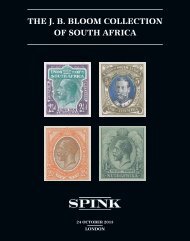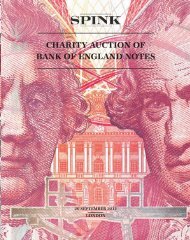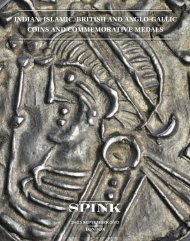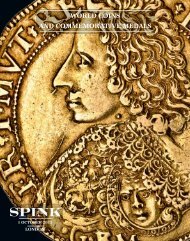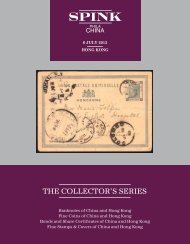bentley priory - Spink
bentley priory - Spink
bentley priory - Spink
Create successful ePaper yourself
Turn your PDF publications into a flip-book with our unique Google optimized e-Paper software.
September 6, 2012 - LONDON<br />
Group Captain P.G.H. Matthews (on left)<br />
D.F.C. London Gazette 13.5.1941 Flight Lieutenant Peter<br />
Gerald Hugh Matthews (40247) - No. 1 Squadron<br />
‘This officer has been engaged on active operations against<br />
the enemy over a long period. He has displayed high qualities<br />
of leadership and exceptional tactical ability. He has<br />
destroyed at least 4 enemy aircraft.’<br />
The Recommendation, dated 23.4.1941, states: ‘This Officer<br />
has been employed on flying duties in an operational<br />
Squadron since September 1939. He has destroyed 4 and<br />
probably 7 enemy aircraft. This is by no means a full measure<br />
of his outstanding qualities of leadership and organisation,<br />
nor of the confusion he has brought to the enemy through<br />
his tactical ability and inspired leadership of his Flight. He has<br />
assumed command on several occasions when his seniors<br />
became non-effective through various reasons, and held the<br />
Flight together; particularly so during the strenuous period<br />
when covering the evacuation from France, and later when<br />
there was considerable action during the Autumn of 1940.’<br />
Queen’s Commendation for Valuable Service in the Air<br />
London Gazette 2.1.1956 Wing Commander Peter Gerald<br />
Hugh Matthews, D.F.C. (40247), Royal Air Force.<br />
Group Captain Peter Gerald Hugh Matthews, D.F.C.,<br />
was born at Hoylake, on the Cheshire Wirrall, 8.5.1919, the<br />
son of Mr. H.T. Matthews, the Chief Veterinary Officer of<br />
Liverpool, and was educated at Quarry Bank School,<br />
Hoylake, and at Liverpool College, where he intended to<br />
train as a vet like his father. However, in August 1937 he<br />
joined the Royal Air Force, being commissioned Pilot<br />
Officer, 24.10.1937, and was posted to No. 5 Flying<br />
Training School, Sealand, before in June the following year<br />
joining the staff at No. 1 Air Armament School at Manby.<br />
Posted to No. 1 Squadron (Hurricanes), Tangmere,<br />
20.8.1939, he went to France with the Squadron at the<br />
outbreak of the Second World War, and was billeted in a<br />
deserted nunnery at Le Harve. Promoted Flying Officer,<br />
23.3.1940, his first notable contact with the enemy came on<br />
the 3rd April 1940: ‘Met 5 Me.109s near Thionville at<br />
26,000 feet. After one diving attack 4 of them continued<br />
downwards and escaped. The remaining one was shot down.<br />
I did not get a chance to fire before the Me.109s ran away’<br />
(retrospective entry in the recipient’s Flying Log book refers).<br />
Two weeks later, on the 16th May he finally got his chance:<br />
‘6 Hurricanes sighted more than 200 German bombers<br />
escorted entering France near Vouziers- attacked 16 Me.110<br />
escort fighters. 8 Me.110s shot down- 1 Hurricane lost. Shot<br />
both engines out of a Me.110 and killed a rear gunner, and<br />
pipped one engine in another. I Destroyed, 1 Probable.’<br />
(ibid). On the 5th June he had further success: ‘12<br />
Hurricanes intercepted about 150 bombers and escort<br />
fighters over Rouen. 8 enemy aircraft were destroyed...the<br />
bombers were turned and did not meet their objectives. Shot<br />
down 1 He.111 and badly damaged another probable’ (ibid).<br />
The Squadron returned to RAF Tangmere, 17.6.1940, and<br />
the following day, covering the evacuation of the British<br />
Expeditionary Force from St. Nazaire, Matthews chased and<br />
shared in the shooting down of a Ju.88, seeing the troopship<br />
Lancastrian sunk during the engagement. As he recalled<br />
many years later; ‘When the big Blitz started we got out in a<br />
hell of a hurry. I had to leave everything for the Germans- my<br />
saxophone, cameras, a very good record player with a<br />
wonderful selection of records, and my golf clubs’ (Article in<br />
the Sunday Express magazine, 11.9.1988 refers).<br />
No. 1 Squadron in the Battle of Britain<br />
Back on home shores at RAF Northolt Matthews was thrust<br />
straight into the Battle and on the 31st July: ‘Intercepted<br />
Do.17 eight miles south of Isle of Wight. Chased to within<br />
ten miles of the French coast. Damaged enemy aircraft but<br />
uncertain as to its destruction. Probable’ (Log Book refers).<br />
During the Battle of Britain he was to have further success,<br />
69



